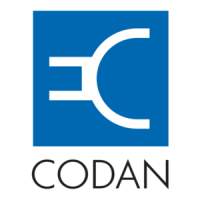NGT—Technical description (2011/2012)
NGT Transceiver System Technical Service Manual 121
Frequency control
Reference oscillator
The reference oscillator is formed by the unbuffered inverter logic gate IC1 and Z1. The
output from IC1 is amplified by IC2 to ensure there is a square wave output. The
14.848333 MHz square wave output is then connected to the DDS ICs IC403 and IC405
via the buffer IC404.
The 14.848333 MHz square wave output is also fed to the 44.5 MHz BPF where the
third harmonic is selected and then buffered by V412 to produce the 44.545 MHz local
oscillator signal (LO2) for IC101 and IC103.
Oven controller
The crystal Z1 is in an oven that runs at approximately 70°C (158°F). The NTC resistor
R3 measures the temperature of the crystal and causes the opamp comparator IC1 to vary
the current in the heating element V2 to maintain the temperature within ±1°C (33.8°F).
The peak current of the oven is limited to 400 mA.
Direct digital synthesis
Local oscillator for upper sideband and lower sideband
IC405 and IC407 divide the reference oscillator frequency of 14.848333 MHz down to
the required 456.5 kHz for USB and 453.5 kHz for LSB. These frequencies may vary
when different optional filters are used.
The frequency information is programmed serially from the on-board microprocessor
IC408.
Drawings 04-03410 and 04-03378 (sheet 3)
NOTE If the PCB issue status is -06 or earlier, see drawing 04-03378 (sheet 3).
Drawing 04-03414
Drawing 04-03378 (sheet 3)
NOTE If the PCB issue status is -06 or earlier, see drawing 04-03378 (sheet 3).

